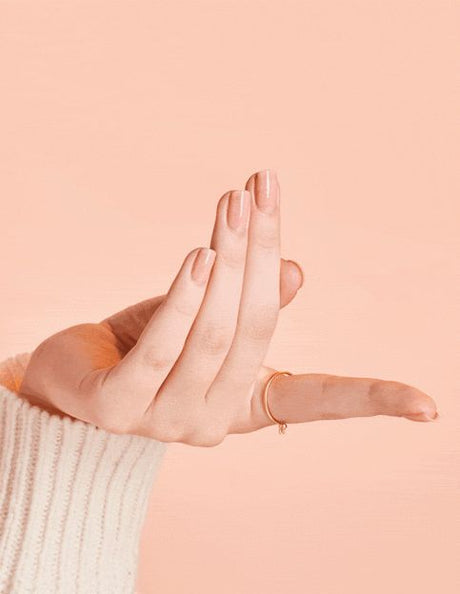This blog post was originally published by Dr. Dana Nails.
We’ve all picked off our nail polish or nibbled on our nails at some point. These actions can be stress and anxiety induced but they can also be a reaction to a lull in activity aka boredom. While some of us are able to stop easily before these behaviors become habit forming, for others the behavior becomes chronic.
If you’ve struggled to stop nail biting, chances are you’re not alone. In fact, it’s estimated that twenty to fifty percent of the population bite their nails.
Thankfully, most nail habits can be treated with behavior modification and if severe, medication and cognitive behavioral therapy. The first step is a matter of knowing how to break the pattern and to divert the behavior to an alternative behavior. Here are four common nail habits with helpful solutions so that you can achieve healthy, beautiful nails.
Habit #1: Picking your nail polish.
Picking your nail polish may seem harmless, but it can cause the nail more harm than good. Every time you pick or peel your polish, the top layer of the nail can inadvertently be removed, which can cause surface irregularities and white patches, also known as keratin granulations.
The solution: Skip the picking and reapply.
There’s something about chipped nail polish that makes us want to pick at it even more. The best course of action? If you see a chip, immediately remove the polish, and reapply a fresh coat. While it may be easier said than done, taking this extra step can help keep your nails healthy.
If you notice that your polish always chips immediately, it may be that your underlying nail needs more TLC. Just like over-processed, dehydrated hair often needs a good deep conditioner, your nails and cuticle need to be effectively hydrated too. The Dr. Dana Nail Renewal System is a wonderful way to prep nails for color application. It creates a smooth, even, healthy canvas, which helps nail polish adhere longer so you’ll get the most mileage out of your manicure.
Habit #2: Picking your hangnails
Those pesky, tiny pieces of loose skin are tempting to pick, but doing so can cause redness, irritation, or bleeding, and can even lead to an infection. Hangnails are often the result of dry skin or lack of nail maintenance, so prioritizing moisture in your nail care routine is important.
The solution: Hydrated cuticles
Keeping your cuticles hydrated is the best way to prevent hangnails. Step 3 of the Dr. Dana Nail Renewal System is a convenient way to keep the entire nail continuously moisturized. A weekly manicure is also a great idea as it maintains the nails and surrounding skin.
Habit #3: Biting your nails
For many, this habit is a result of boredom or stress and habit cessation can be a difficult thing to do. Before you nibble, keep in mind that you are not only weakening your nails, but you are also exposing your yourself to a hotbed of germs and bacteria.
The solution: Divert the behavior
Dr. Dana recommends keeping a diary for a week and writing down every time you catch yourself biting. Specify where you are exhibiting the behavior (ie at the computer vs. in the car), what you think the trigger is (stress vs boredom for example). The idea is to establish a pattern of behavior so that you can trade the biting for a competing, alternative behavior. A very effective method is to wear a bright colored rubber band around your wrist which can serve as a visual reminder and can be manipulated when there is an urge to bite.
If your nails and cuticles are not too severe, a weekly professional manicure can also help because when you spend time and money maintaining your nails, you are theoretically less inclined to ruin them. This would not be recommended for people with severe cuticle damage.
There are some cases where chronic nail biting can result in nail shape changes such as the development of short, wide nails (known as brachyonychia) and is something that may need to be discussed with your doctor.
Habit #4: Using your nails as tools
We’ve all been there. Once you’ve discovered how useful your nails can be to tighten a loose screw or remove labels, it’s hard to resist the urge to use them as tools.
No matter how strong your nails are or how handy they may be in a pinch, using your nails as tools can lead to breakage, splits and damage to the cuticle.
The solution: Go the extra mile and find an alternative
To protect the health of your nails, take some time to find the proper tool that you need or ask someone with short nails to help you. Sometimes all it takes is a bit of creativity to complete the task at hand, but in the end, it’ll save your manicure!
If you’re still struggling with the aforementioned habits after trying our recommended tips, consider seeking help from your dermatologist. Habits are hard to break, especially habits that have been going on for years. Cognitive behavioral therapists are also a very helpful resource for those who need on going strategies and tips.
